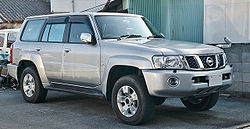- Nissan Patrol
-
Nissan Patrol 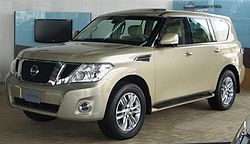
Manufacturer Nissan Production 1951–present Assembly Kyushu, Japan (Nissan Shatai Plant) The Nissan Patrol is a four-wheel drive vehicle manufactured by Nissan in Japan since 1951. In Japan since 1980, it has been known as the Nissan Safari. The Patrol is available in Australasia, Central and South America, South Africa, parts of Southeast Asia and Western Europe as well as Iran and the Middle East. In 2010 it became available in the United States and Canada as the upscale 2011 Infiniti QX56, which had shared the same platform as the US-built Nissan Armada from 2004 to 2010.
The Patrol has been available as either a short-wheelbase (SWB) three-door or a long-wheelbase (LWB) five-door chassis. The LWB version has also been offered in utility and cab chassis variants alongside the wagon. Between 1988 and 1994, Ford Australia marketed the Patrol as the Ford Maverick. The Maverick was available alongside the Nissan-branded Patrol. Also, in some European countries the Patrol was, for a short while marketed as Ebro Patrol. The Patrol was always regarded as a tough 4X4 in Australia, Middle East, Europe and the Caribbean. Its stronghold is the Middle East, Australia, New Zealand, Japan and other European Countries. Its major competitors are Toyota Land Cruiser, Land Rover Discovery and Mitsubishi Pajero.
The second generation Y60 (GQ) platform is still manufactured as a military vehicle in the countries of Asia and the Middle East, and various versions of the Patrol are widely used by United Nations agencies. These Y60 models are produced alongside the current Y61.
Nissan Patrols, fourth and fifth generation, are the main troop transport vehicles used by the Irish Army.
Contents
First generation (4W60 series; 1951–1960)
First generation 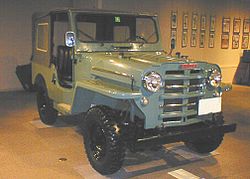
Production 1951–1960 Class Mid-size off road vehicle, Pickup Body style 3-door compact SUV
2-door Pickup
fire truckLayout Front engine, rear-wheel drive Engine 3.7 L I6, 75 hp (56 kW)
3.7 L Transmission4-speed(Manual transmission) In September 1951 the 4W60 was introduced. The overall styling was similar to the Willys Jeep. The 4W60 used the 75 hp 3.7L Nissan NAK engine from the Nissan 290 bus, but with part-time 4-wheel drive and a 4-speed manual transmission. The grille had a pressed-steel Nissan badge. A 4W70 Carrier-based wagon was available. The 4W60 was replaced with the 4W61 in August 1955.
The 4W61 was introduced in August 1955. The 4W61 was similar to the 4W60 with the exception of the grille (with some chrome bars), a one-piece windshield that sits further back when folded, chrome strips on the hood, and unequal sized seats (passenger's side is wider than the driver's). The other big change is the engine. The 4W61 was powered by the new 3.7L Nissan NB engine, producing 92 hp, and later was powered by the 105 hp 4.0L Nissan NC engine. The grille badge was chrome and red and said "NISSAN". In October 1958, the 4W61 was discontinued and replaced with the 4W65.
In October 1958 the 4W65 Patrol was introduced. The 4W65 was similar to the 4W61 except for the grille, which now had all chrome bars and redesigned front fenders and hood. A "NISSAN" badge was on the grille, and "Patrol" badges were added on the sides of the hood. An 8-seater hardtop wagon, the WG4W65, was available. The short-lived 4W66 Patrol was introduced in December 1959. The only change is that the 4W66 was powered by the 125 hp 4.0L P engine. The 4W66 was discontinued in June 1960.
4W70 Series
The Nissan 4W70 Carrier was introduced in 1950 and was based on the Dodge M37. The 4W70 used the M37's chassis, but used the 4W60 Patrol drivetrain and engine. The grille was also different, being narrower, and different front fenders. The 4W72 was introduced in 1955 (the 4W71 designation was skipped) with changes to the hood, grille and headlights. Power increased to 105 hp thanks to the new Nissan NC engine. Modifications again to the hood, fenders and grille and an increase in power to 145 hp led to the 4W73, introduced in 1959 and now powered by the Nissan P engine.
Series Body styles Engines (gasoline) 4W60 series
(Later named Nissan Patrol)SWB: soft top (4W60, 61,65,66)
SWB: fire truck (F4W61,65,66)NAK/NB/NC/P Nissan Carrier
4W70/72/73Troop carrier, weapon carrier NC/P Second generation (60 series; 1960–1980)
Second generation 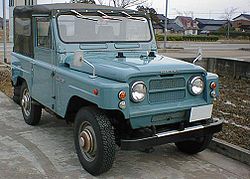
Production 1960–1980 Class Mid-size off road vehicle, Pickup Body style 3-door soft top/hard top/wagon/van
5-door wagon/van
2-door Pickup
fire truckLayout Front engine, four-wheel drive Engine 4.0 L P I6 Transmission 3/4-speed Manual transmission The soft-top Nissan Patrol 60 (two-door; 2,200 mm (86.6 in) wheelbase) and G60 (two-door; 2,500 mm (98.4 in) wheelbase) were first sold in Australia in 1960. Left-hand drive L60/GL60 models were sold outside of Australia. The 60 series gained attention as the first vehicle to drive across the Simpson Desert in Australia. US customers could not get Patrols until the mid-seventies. An extra long wheelbase version, the H60, was also available.
The 4WD Nissan Patrol 60 series was produced in short, medium and long wheel-base versions. It had a manual transmission type-F3B83L at first with three and later with four speeds, 2-speed transfer case with part-time four-wheel drive. The motor was the P engine, a 3,956 cc (241.4 cu in) inline overhead-valve six-cylinder, featuring bathtub-shaped combustion chambers and a fully balanced seven-bearing crank shaft. With two doors in front and one at the back and four seats (driver, and companion in front, two parallel back seats), the extra long wheelbase version (the H60) was available with eight-passenger capacity.
Other characteristics are:
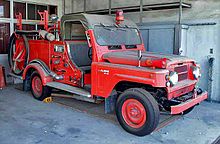
Nissan Patrol FH60 firetruck- Wheelbase: 2.2/2.5/2.8m (9 ft 2 in, 110")
- Max load: 1,000 kg (2,205 lb)
- Bore: 85.7 mm (3.4 in)
- Stroke: 114.3 mm (4.5 in)
- Suspension: live-leaf/live-leaf
- Brakes: drum/drum
- Tyres: 7.50x16;
- Fuel tank 64 L (14.1 imp gal; 16.9 US gal) capacity
In 1963, the KG60 (and KGL60) hard-top models were introduced. The front-end styling of the 60 series resembles the Toyota Land Cruiser.
Series Body styles Engines (gasoline) 60 series 60:SWB: soft top, K60 hard top
G60:LWB: WG60 station wagon, G60H-A cab/chassis, 62ZG60H pickup truck
H60:Super LWB: VH60 van, FH60 fire truckP engine Jonga
In the 1960s, the Indian Army showed an interest in two vehicles from the Nissan stable, they were the Nissan Patrol P60 & the Nissan 4W73. The first production units were completed at Vehicle Factory Jabalpur (VFJ) around 1969. The name as per the Indian army records is Jonga, which is an acronym for Jabalpur Ordinance aNd Guncarriage Assembly. It was built at the newly commissioned Vehicle Factory Jabalpur alongside the Nissan 4W73. The first production units were completed at Vehicle Factory Jabalpur (VFJ) around 1969. VFJ was sanctioned in 1965 for the production of three non-fighting vehicles for the Indian military: the 3 ton Shaktiman truck from MAN (Germany), the 4W73 (one-ton Carrier) and quarter-ton Nissan Patrol.
Interestingly, both the vehicles from Nissan stable were fitted with the same engines and lots of parts in common.
The Jonga was also briefly sold to civilian customers with a 4.0 L Hino diesel engine in 1996, but the demand was low, mostly due to an uncompetitive price, as well as its unappealing looks. Less than two hundred units were sold in all.
Jonga served faithfully until the late 1990s, when it was replaced by the lighter Mahindra & Mahindra MM550 jeeps. Many army auctioned pieces have also been scrapped by their subsequent civilian owners, or stretched and converted to people carriers in rural areas. The Jonga is now becoming a rarity.
Third generation (1980-1989/-1994)
160 Series (MQ / MK), 1980–1989
Third generation 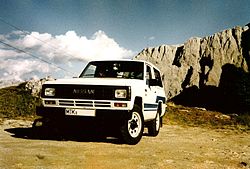
Also called Nissan Safari, MQ, MK, Samurai Production 1980–1989 Body style 3-door soft top/hard top
5-door wagon/van
2/4-door Pickup
fire truckLayout Front engine, rear-wheel drive/four-wheel drive Engine 2.8 L L28/L28E I6
4.0 L P40 I6
3.3L SD33 Diesel
3.3L SD33T TurbodieselTransmission 4/5-speed manual transmission
3-speed 3N71 automaticThe 160 series was introduced in 1980 to replace the 60 series. In Australia, these are officially known as the MQ Patrol. In 1980, the engines available were the L28, P40 and SD33. All models were available with a four-speed manual transmission, albeit a three-speed automatic was optional on long wheelbase vehicles fitted with the L28 engine. All 160 series Patrols came with a two-speed offset transfer case, which featured a 1:1 high gear and a low gear.
All models had leaf sprung suspension. The SD33 vehicles feature 24 volt electrics. Different trim options and colors were available, with options including vinyl or carpet floors, and blue or brown interior trim. Air conditioning and power steering were available on deluxe models.
The front differential in all models was C200. In Australia, the standard rear differential was the H233. Some versions featured limited slip differentials (LSD). A heavy duty model rear differential was used in some pickup trucks and P40 engined wagons. This was the H260 model differential. In European markets, where less onerous off-road use was expected, the light duty C200 rear differential was installed in some vehicles.
In 1983, the MQ model was updated (like a series 2). These are commonly known as an MK Patrol, however this does not appear on any Nissan literature or service manuals. Nissan parts dealers do not recognise these initials either. Updates included revised front end with rectangular headlights and an upgraded front suspension. The four-speed gearbox was revised and a fifth gear was added for most models. The four-speed was still used in some lower specced utes, presumably to run out stock.
The SD33 diesel engine was also updated at this time. Revisions included the use of three piston rings instead of five, piston oil squirters and spin on oil filter instead of a paper cartridge type. In Australia and some other parts of the world, the SD33-engined Patrols were also revised to standard 12 volt electronics. A turbocharged diesel model was also introduced, known as the SD33T. To accommodate the extra power, it features a larger clutch (270 versus 240 mm) and larger oil cooler (five rows versus three) than does the naturally aspirated version.
260, 1986–1994
Spanish built 260 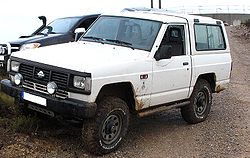
Also called Nissan Safari Production 1986–1994 Class Full-size 4x4, Pickup Body style 3-door Hardtop
5-door Wagon/Van
2-door Pickup
4-door PickupLayout Front engine, rear-wheel drive / four-wheel drive Engine 2.8L L28 I6
4.0L P40 I6
2.8L RD28T DieselTransmission 5-speed(Manual transmission) Wheelbase (LWB) 2,970 mm (116.9 in),(SWB) 2,350 mm (92.5 in) Length (LWB) 4,690 mm (184.6 in),(SWB) 4,230 mm (166.5 in) Width (LWB)1,689 mm (66.5 in),(SWB) 1,689 mm (66.5 in) Height (LWB) 1,980 mm (78.0 in),(SWB) 1,980 mm (78.0 in) The 260 series was a Spanish-built version of the 160 (easily spotted by the rectangular headlamps) sold in Europe and was available in SWB / LWB and with L28, SD33 and RD28T engines. The SD-engined version, at least in the UK market, had a 24-volt electrical system. The 260 Patrol later received a facelift with a new grille similar to that of the Y60 series which succeeded this generation elsewhere. Spanish production continued until 1994.
Fourth generation (Y60; 1987–1997)
Fourth generation 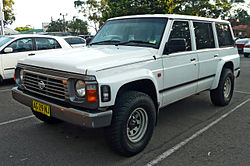
Also called Nissan Safari
Ford Maverick (1988–1994)Production 1987–1997 Class Full-size 4x4, Pickup Body style 3-door hard top
5-door wagon/ban
2-door Pickup
4-door PickupLayout Front engine, rear-wheel drive / four-wheel drive Engine 3.0L RB30S I6
4.2L TB42S/TB42E I6
2.8L RD28T Turbodiesel
4.2L TD42 DieselTransmission 5-speed,4-speed (Automatic transmission, Manual transmission)[clarification needed] Wheelbase (LWB) 2,970 mm (116.9 in),(SWB) 2,400 mm (94.5 in) Length (LWB) 4,845 mm (190.7 in),(SWB) 4,285 mm (168.7 in) Width (LWB) 1,930 mm (76.0 in),(SWB) 1,930 mm (76.0 in) Height (LWB)1,815 mm (71.5 in),(SWB) 1,810 mm (71.3 in) The Y60 was radically different mechanically from its predecessors as it now had coil sprung suspension, the rear axle being on a 5 link setup. Most models had a rear Limited slip differential and some variants had a vacuum operated manual rear differential lock. The model now had rear disc brakes and some Y60s even had a PTO-driven front-mounted winch.
From 1988 to 1994, Ford Australia rebadged the Y60 (GQ) Patrol, as the Ford Maverick. This was a result of the Button car plan devised by the Government of Australia.
Fifth generation (Y61; 1997–Still in production)
Fifth generation Also called Nissan Patrol Super Safari
Nissan Seranza (IR; Pars Khodro)Production 1997–present Class Full-size SUV, Pickup Body style 3- door SUV
5-door SUV
2-door Pickup
4-door PickupLayout Front engine, rear-wheel drive / four-wheel drive Engine 4.5 L TB45E I6, 197 hp (147 kW)
4.8 L TB48DE I6, 248 hp (185 kW)
2.8 L RD28ETi Diesel, 133 hp (99 kW)
3.0 L ZD30DDTi Diesel, 158 hp (118 kW) or 170 hp (127 kW)
4.2 L TD422 Diesel, 123 hp (92 kW)
4.2 L TD42T3 Diesel, 158 hp (118 kW)Transmission 4-speed Automatic transmission
5-speed Manual transmissionWheelbase 2,970 mm (116.9 in) Length 5,080 mm (200.0 in) Width 1,940 mm (76.4 in) Height 1,855 mm (73.0 in) Y61 (GU) models first appeared in 1997, available in 4.5L petrol and 2.8L Turbo Diesel, 3.0L Turbo Diesel, 4.2L diesel, 4.2L Turbo Diesel, 4.2L Turbo Diesel Intercooler variants.
The underbody hardware (diffs, CVs etc.) were significantly strengthened and are considered to be the strongest componenents fitted to any production 4WD. Comfort levels were also increased over GQ, especially in the seating and NVH areas.
In 2004 a significant facelift model was released, with new headlights, box flares on each guard, and larger tail lights. That same year, Nissan stopped selling the Safari in Japan due to poor sales. Nissan also makes a two-door pickup version of the Y61 series available as cab chassis and with a style side tray in some markets. Although a new model has been launched, this Y61 series will still sell for off-road enthusiasts but only with few options as a basic trim.
Its TB48DE engine is very famous and popular among UAE tuners, where it could be easily modified and upgraded to levels where it could beat some supercars produced by Lamborghini, Ferrari, Nissan and other supercar producers. In one occasion a TB48DE engine was fully modified and was able to reach over 2,000 hp (1,491 kW) for the sand hills challenges.
The Fifth Generation Patrol is still in production alongside the new Sixth Generation Patrol in many markets around the world, such as Australia and Europe, which have not yet received the new Sixth Gen model. It is probable that the Fifth Generation Patrol may still receive an update with a new diesel powerplant to allow the model to remain in production as a cheaper variant of the Patrol for some time still to come.
Sixth generation (Y62; 2010–)
Sixth generation 
Also called Nissan Safari
Nissan Patrol Royale
Infiniti QX56Production 2010– Class Full-size SUV Body style 5-door SUV Layout Front engine, rear-wheel drive / four-wheel drive Engine 5.6 L VK56VD 32-valve V8 with VVEL, 400 hp (298 kW), 413 ft·lbf (560 N·m)
5.6 L VK56DE[1] 32-valve V8, 317 hp (236 kW), 385 ft·lbf (522 N·m)
4.5 L TB45DE 24-valve V6 OHV, 230 hp (172 kW)
4.8 L TB48DE 24-valve V6 DOHC, 280 hp (209 kW), 294 ft·lbf (399 N·m)Transmission 7-speed automatic
5-speed automatic
6-speed manual[2]
5-speed manualWheelbase 3,075 mm (121.1 in) Length 5,140 mm (202.4 in) Width 1,995 mm (78.5 in) Height 1,940 mm (76.4 in) Curb weight 2,785 kg (6,140 lb) The all-new 2010 Nissan Patrol was launched on 13 February with the slogan 'Hero of All Terrain', at a VIP event in Abu Dhabi, UAE.[3] It is the base for the new Infiniti QX56.
The 2010 Nissan Patrol is powered by VK56VD (5.6-litre) V8 with a 400 hp (298 kW) an 560 N·m (410 ft·lbf), with features such as "VVEL" Variable Valve Event and Lift and "DIG" Gasoline direct injection, and mated to a 7-speed automatic. A variable 4×4 Mode package allows switching between four drive modes: sand, on-road, rock and snow, with the flick of a switch. And a "Hydraulic Body Motion Control System" system is available. Also available are an electronic-locking rear differential, hill start and hill descent control, as well as lane-departure warning, automatic braking and stability control. The Infiniti version launched in the United States in 2010. The Nissan Patrol version will launch in Australia and the rest of the world next year. U.S. models have a 5.6 V8, while models in other markets are motivated by V6 and V8 turbo diesel engines and a V6 petrol engine.
For 2011, Nissan Patrol Y62 is offered in a newly developed 6 speed manual transmission mated to a VK56DE.
The Nissan Patrol is offered in three different levels of trim an six different models in the Middle East: LE, SE, and City Package.
Features:
- Intelligent Key – A sensor is triggered when the remote is brought near the vehicle, allowing the user to open it with the touch of a knob.
- Push Start – Start/Stop push button for ignition; a key is not required.
- Curtain Vent – Curtain Vent has several small but highly effective vents mounted in the ceiling above each side window to blow a strong current of cool air down forming a curtain of air that acts as a barrier to heat penetrating the cabin.
- TPMS – The new model employs a revised Tyre Pressure Monitor System (TPMS) with tyre inflation indicator which beeps the horn softly to inform drivers that a suitable tyre pressure has been reached.
- ALL MODE 4x4 system Four-wheel drive – Allows the driver to quickly switch between four drive modes: sand, on-road, snow and rock, with the flick of a switch.
- Hydraulic Body Motion Control System – The new Patrol employs HBMC with 4-wheel independent suspension.
- Intelligent Cruise Control (Cruise control) -Slows your vehicle to maintain the desired distance between you and slow traffic, and re-accelerates to your pre-set speed and distance as the traffic flow picks up. Distance Control Assist. Helps the driver release the throttle and applies brakes as needed in slowing traffic.
- Around View Monitor – The 4 cameras of the AVM come alive to help you park the vehicle even in the tightest of spots.
- 9.3 GB Music Box Hard Drive – Enjoy your personal music library. With the category’s first "Music Box", you can record close to 2,900 songs up to 9.3 GB storage. Connects to iPod®, USB flash drive and other compatible device.
- Hill Start Assist & Hill Descent Control system – Sail through the ups & downs. The advanced system assists you in both climbing and descending from a slope by controlling the brakes and adjusting the vehicle speed.
- Locking differential – The available electronic locking rear differential allows you to pull out of mud or loose sand by distributing torque evenly to the rear wheels.
- (LDWS) Lane Departure Warning System – The system helps avoid unintended lane departure. LDW warns the driver with an alarm and an indicator to brake. LDP assists the driver to bring the vehicle back to the lane by applying the brake.
- Intelligent Brake Assist – If the driver doesn’t respond to the warning, and a collision cannot be avoided, IBA automatically engages the brakes to help reduce collision speed and impact, mitigating the consequences of the accident.
- Vehicle Dynamic Control (Electronic stability control) – Combines with Traction Control System and Brake LSD (Limited Slip Differential) functions to automatically prevent the Patrol from sliding sideways on slippery road surfaces when changing lanes or negotiating a curve.[4]
References
- ^ http://www.drivearabia.com/news/2011/09/06/nissan-patrol-2012-manual-gearbox-model-dubai-uae/
- ^ http://www.drivearabia.com/news/2011/09/06/nissan-patrol-2012-manual-gearbox-model-dubai-uae/
- ^ http://www.nissan-global.com/EN/NEWS/2010/_STORY/100213-01-e.html Nissan Patrol new class-leader as Nissan's 'Hero of All Terrain'
- ^ "Nissan Patrol 2010 launched in Abu Dhabi". DriveArabia.com. 2010-02-14. http://www.drivearabia.com/news/2010/02/14/nissan-patrol-2010-launch-abu-dhabi-dubai-uae/. Retrieved 2010-02-20.
External links
 Media related to Nissan Patrol at Wikimedia Commons
Media related to Nissan Patrol at Wikimedia Commons  Media related to Nissan Safari at Wikimedia Commons
Media related to Nissan Safari at Wikimedia CommonsNissan Motor Company Vehicles Current370Z • Advan • Altima • Aprio • Armada • Atlas • Bluebird • Bluebird Sylphy • Cabstar • Caravan • Civilian • Clipper • Cube • Dualis • Elgrand • Frontier • Freeson • Fuga • GT-R • Juke • Lafesta • Leaf • Livina Geniss • Maxima • March • Murano • Moco • Navara • Note • NV200 • NV400 • Otti • Paladin • Pathfinder • Patrol • Qashqai • Quest • Rogue • Safari • Sentra • Serena • Skyline • Teana • Tiida • Titan • Urvan • Versa • Wingroad • X-Trail • XterraPastDC-3 • 100NX • 1200 • 310 • 180SX • 200SX • B-210 • 240SX • 240Z • 280ZX • 300C • 300ZX • 350Z • 510 • 810 • Almera • Almera Tino • Altra (EV) • Avenir • Auster • Bassara • Be-1 • Caball • Cablight • Cedric • Cefiro • Cherry • Cima • Crew • Datsun Truck • Echo • Expert • Fairlady • Figaro • Gazelle • Gloria • Hardbody Truck • Hypermini • Homy • Interstar • Junior • Largo • Laurel • Leopard • Liberty • Mistral • Multi • NX • Pao • Pintara • Pino • Platina • Prairie • Presage • Presea • Primera • President • Pulsar • Pulsar GTI-R • R390 GT1 • R'nessa • Rasheen • Roadster-Road Star • S-Cargo • Saurus • Saurus Jr • Silvia • Sileighty • Skyline GT-R • Stanza • Stagea • Sunny • Terrano • Terrano II • Vanette • VioletConcept126X • 216X • 270X • 300 Bambu • 315-a • AA-X • Actic • AD-1 • AD-2 • AL-X • Alpha T • Amenio • AQ-X • AP-X • ARC-X • AXY • AZEAL • Bevel • Boga • C-Note • Chapeau • Chappo • Cocoon • CQ-X • Crossbow • CUE-X • Cypact • Duad • Dunehawk • Effis • ESV • Evalia • EV Guide II • EV Truck • FEV • FEV-II • Foria • Forum • Fusion • Gobi • GR-1 • GR-2 • GT-R • ideo • Intima • Jikoo • Judo • Jura • Kino • KYXX • Land Glider • LEAF • LUC-2 • MID4 • Mixim • mm.e • Moco • Nails • NCS • NEO-X • NRV-II • NX-21 • NV2500 • Pivo • Pivo 2 • Qazana • Redigo • Round Box • Serenity • Sport Concept • Stylish VI • Terranaut • Tone • Townpod • Trailrunner • TRI-X • URGE • UV-X • XIX • XVL • Yanya • ZarootEngines GRX-3 • UD12 • VRT35Marques Nissan • InfinitiSubsidiaries
and divisionsSee also ATTESA • Datsun • HICAS • Prince • Renault-Nissan Alliance • Nissan Shatai • UD Nissan Diesel • VVL • VVEL • dCi
Nissan car timeline, European market, 1980s–present Type 1980s 1990s 2000s 2010s 0 1 2 3 4 5 6 7 8 9 0 1 2 3 4 5 6 7 8 9 0 1 2 3 4 5 6 7 8 9 0 1 Supermini Micra K10 Micra K11 Micra K12 Micra K13 Small family car Cherry N10 Cherry N12 Sunny B310 Sunny B11 Sunny N13 Sunny N14 Almera N15 Almera N16 Tiida C11 Large family car Stanza T11 Bluebird 910 Bluebird U11 Bluebird T12/T72 Primera P10 Primera P11 Primera P12 Executive car Laurel C31 Laurel C32 Maxima J30 Maxima QX A32 Maxima QX A33 Teana J31 Teana J32 Coupé Silvia S110 Silvia S12 200SX S13 200SX S14 Sports car 280ZX 300ZX Z31 300ZX Z32 350Z Z33 Mini MPV Note Compact MPV Prairie M10 Prairie M11 Almera Tino Large MPV Serena C23 Serena C24 Serena C25 Mini SUV Juke Crossover SUV Qashqai Qashqai+2 X-Trail T30 X-Trail T31 Murano Z50 Murano Z51 Terrano WD21 Pathfinder R50 Pathfinder R51 Off-roader Terrano II Patrol 160 Patrol Y60 Patrol Y61 Patrol Y62 Categories:- All wheel drive vehicles
- Nissan vehicles
- Off-road vehicles
- Vehicles introduced in 1980
Wikimedia Foundation. 2010.





